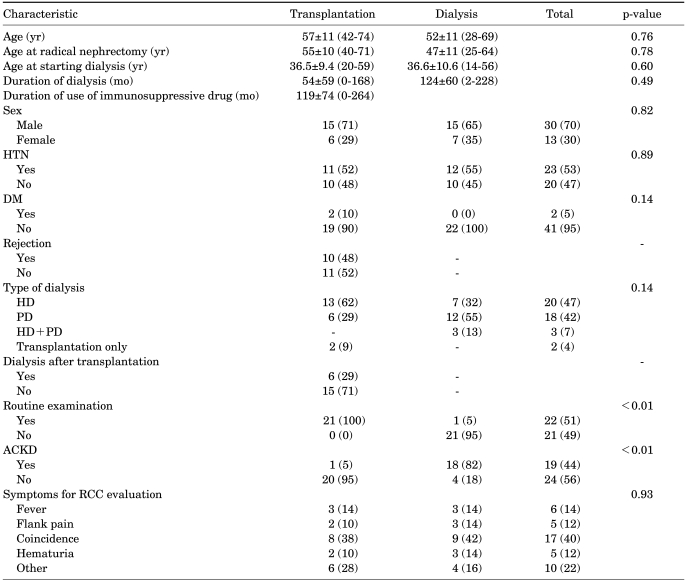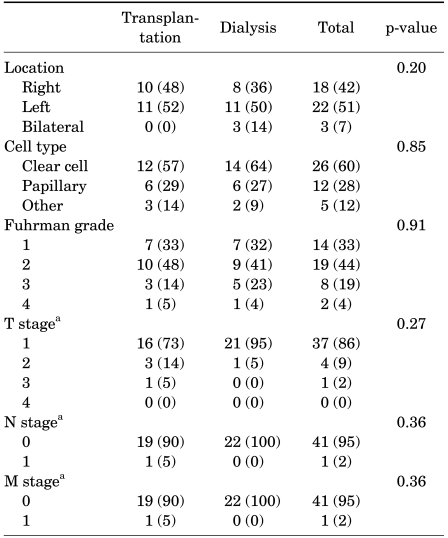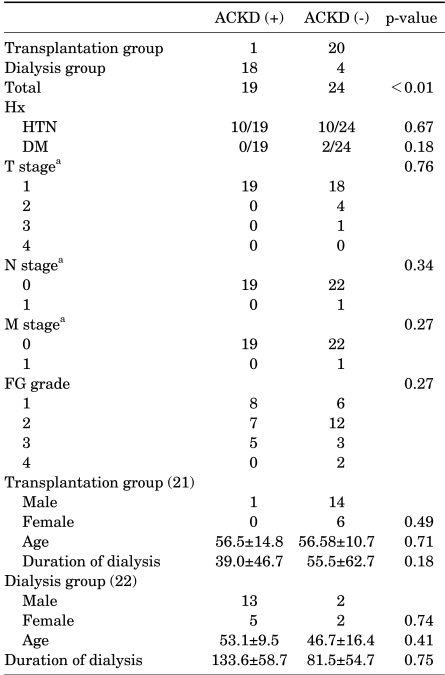Abstract
Purpose
In a group of surgery patients diagnosed with renal cell cancer, those who underwent dialysis were compared with those who received a kidney transplant.
Materials and Methods
The 43 subjects included in this study were patients who had been undergoing dialysis because of end-stage renal disease or had undergone kidney transplantation. The patients were diagnosed with renal cell carcinoma (RCC) during follow-up and underwent radical nephrectomy from May 1996 to December 2010. Their medical records were retrospectively analyzed as part of the study.
Results
In the transplantation group, the renal replacement therapy period averaged 54 months, and the period from transplantation to RCC averaged 119 months (range, 0 to 264 months). In the dialysis group, RCC was observed after an average of 124 months (range, 2 to 228 months) of dialysis, and nephrectomy was then conducted. Acquired cystic kidney disease (ACKD) was found more frequently in the dialysis group, and it had a statistically relevant effect on the occurrence of RCC by comparison with the transplantation group (p<0.01).
Conclusions
Although the incidence rate of ACKD was significantly higher in the dialysis group among patients undergoing surgery for RCC, cancer was found even without ACKD development in some transplant recipients. Considering that the transplant recipients also underwent dialysis, an informative prospective study will be necessary to determine whether other immunosuppressive agents besides ACKD may function as a cancer risk factor.
Keywords: Cystic kidney disease, Dialysis, End stage renal disease, Kidney transplantation, Renal cell carcinoma
INTRODUCTION
Renal cell carcinoma (RCC) accounts for approximately 2 to 3% of cancer in adults of the general population. Compared with other types of cancer, RCC is difficult to diagnose and shows different clinical patterns [1]. In particular, RCC is associated with such a low survival rate in kidney transplantation patients that studies on the correlation between the transplantation and the cancer have recently been conducted [2].
After diagnosis with end-stage renal disease (ESRD), transplantation patients take immunosuppressive agents for preservation of the transplanted kidney, and the use of such agents since the 1970s has been reported to raise the occurrence of malignancy [2]. Immunosuppressant therapy was used in the past to prevent rejection, but this type of therapy has actually decreased the survival rate by increasing cancer occurrence [3]. The incidence rate of cancer in patients using immunosuppressive agents is approximately 2 to 5 times higher than in healthy controls. According to a previous study, the incidence rate of cancer is 10 times higher in renal transplant recipients than in dialysis patients [4].
Acquired cystic kidney disease (ACKD) is known to be frequently observed in dialysis patients with chronic renal failure and patients using immunosuppressive agents after transplantation [5]. In particular, ACKD needs careful follow-up as a pre-malignant lesion. ACKD is found mainly in patients on dialysis, and its existence influences the occurrence of cancer. ACKD was reported to be observed in 20% of patients on dialysis for 1 to 3 years and in >90% of those on dialysis for 5 to 10 years [5]. ACKD increases the prevalence of RCC by around 20%. For transplant recipients among ESRD patients undergoing dialysis, the incidence rate of RCC is known to be 40 to 100 times higher than in healthy controls [6].
Previous studies investigated only the occurrence of ACKD and RCC in dialysis patients and the occurrence of RCC in the native kidney after kidney transplantation. There have been no reports comparing dialysis patients and transplant recipients among RCC patients.
In the present study, we examined ACKD development and the correlation between dialysis duration and the occurrence of RCC. Two groups of patients were defined from among those who had been diagnosed and surgically treated for RCC: those who had undergone kidney transplantation (±dialysis) and those who had undergone dialysis only. The purpose of this investigation was to determine whether there was a pathologic difference between the two groups.
MATERIALS AND METHODS
The study included 43 patients diagnosed with RCC during follow-up among patients undergoing dialysis owing to ESRD and renal transplant recipients. The patients' medical records were analyzed for age, age at radical nephrectomy, age at starting dialysis, duration of dialysis (months), duration of use of immunosuppressive drugs (months), gender, medical history, type of dialysis, dialysis after transplantation, routine examination, presentation of ACKD, and symptoms for RCC evaluation, retrospectively. We took an examination of all patients by computed tomography (CT). ACKD was found by CT by a radiologist. The patients were diagnosed with RCC and underwent radical nephrectomy or renal biopsy from May 1996 to December 2010.
For the classification of RCC cell type, mixed histologic type was considered as a dominant pattern. Tumor stage was determined by the tumor size, metastasis to node, and metastasis classification and cellular grade was classified as G1 to G4.
All data were analyzed by univariate analysis. The chi-square test was used with nominal variables; Student's t-test was used with continuous variables. The p-values of <0.05 were considered to be significant. Statistical analyses were conducted by using IBM SPSS ver. 18.0 (IBM Co., New York, NY, USA).
RESULTS
This study compared dialysis patients and transplant recipients who had been diagnosed with RCC and had been surgically treated. As summarized in Table 1, the mean age of the transplantation and dialysis groups was 57±11 and 52±11 years, respectively. Comparison between the two groups did not show any significant differences in gender distribution (p=0.82), blood pressure (p=0.89), or the existence of diabetes (p=0.14) (Table 1).
TABLE 1.
Patient characteristics before renal cell cancer (RCC) diagnosis
Values are presented as mean±SD (range) or number (%).
HTN, hypertension; DM, diabetes mellitus; HD, hemodialysis; PD, peritoneal dialysis; ACKD, acquired cystic kidney disease.
In 42 cases among the total patients, RCC was diagnosed through radical nephrectomy, and in the other 1 case it was pathologically confirmed through renal biopsy. Of the 43 patients, 21 underwent kidney transplantation after dialysis, and the other 22 were on dialysis. Of the 21 patients who underwent kidney transplantation, 13 patients had histories of prior hemodialysis (HD) treatment. Whereas six patients underwent only peritoneal dialysis (PD), two patients had undergone kidney transplantation without dialysis after being diagnosed with ESRD. Ten patients developed post-transplantation acute or chronic rejection, and six of these were on dialysis because of rejection of the transplanted kidney. The duration of dialysis following rejection was less than 1 month, and the transplanted kidney could be saved after dialysis or by using immunosuppressive agents. One patient underwent a second transplantation owing to chronic rejection. In addition, one patient developed membranoproliferative glomerulonephritis, which was dealt with by removal of the transplanted kidney and treatment with PD. The remaining patients were treated by immunosuppressive agents. Among the 22 dialysis patients, seven men received HD, whereas 12 patients received PD. Three patients switched during treatment from PD to HD (Table 1).
Of the total of 7,009 dialysis patients in our hospital, 0.3% (22 patients) were surgically treated for RCC, and 82% of those (18 patients) had ACKD. Among the total of 2,757 renal transplant recipients in our hospital, 0.8% (21 patients) were diagnosed with RCC, and 5% (1 patient) of those had ACKD (Table 1).
In the transplantation group, the subjects underwent transplantation after an average period of 54 months (range, 0 to 168 months) of renal replacement therapy, and the average period from transplantation to nephrectomy due to RCC was 119 months (range, 0 to 264 months). In the dialysis group, RCC was found after an average of 124 months (range, 2 to 228 months) of dialysis and was treated by nephrectomy. The transplantation subjects underwent mainly HD, and dialysis subjects in most cases received PD treatment. However, the difference in dialysis modality had no statistical significance with respect to the occurrence of RCC (p=0.14) (Table 1).
In the transplantation group, we took a routine examination by ultrasonogram or CT (22 patients). The dialysis group did not undergo a routine examination by ultrasonogram or CT except for one patient in whom another cancer was diagnosed (Table 1).
For symptoms leading to RCC evaluation, RCC was suspected coincidentally during follow-up by CT or ultrasonography in 8 patients (38%) of the transplantation group and in 9 (41%) of the dialysis group. When RCC characteristics were investigated after the surgery, there were no statistically significant differences in the cancers as to side of occurrence (p=0.2), cell type (p=0.85), Fuhrman grade (p=0.91), T stage (p=0.27), N stage (p=0.36), or M stage (p=0.36) between the two groups (Table 2).
TABLE 2.
Clinical and pathologic data for patient with renal cell cancer (RCC) in renal replacement therapy
Values are presented as number (%).
a: One patient underwent renal biopsy only (transplanted group).
ACKD was found more often in the dialysis group, and it affected the occurrence of RCC in the comparison with the transplantation group (p<0.01) (Table 1, 3).
TABLE 3.
Clinical and pathological data in patients by acquired cystic kidney disease (ACKD)
Hx, patients past medical history; HTN, hypertension; DM, diabetes mellitus; FG, Fuhrman grade.
a: One patient underwent renal biopsy, only (transplanted group).
DISCUSSION
Since Dunnill et al. [7] first referred in 1977 to the correlation between RCC and ACKD following ESRD, some studies have confirmed a relationship between ESRD and the occurrence of RCC. In 1992, Chandhoke et al. [8] found no correlation between the two. However, in 2006 Moudouni et al. [4] observed that the incidence of RCC in the native kidney was high in transplant recipients, and Kojima et al. [9] reported that the incidence rate was high in dialysis patients. In the latter study, it was shown that 44 (1.68%) of 2,624 ESRD patients followed up during dialysis developed RCC an average of 11.2 years after dialysis, and 36 of these cases (81.8%) were associated with ACKD. A positive correlation with the incidence rate of RCC was also found among transplant recipients [9]. In 2007, Ianhez et al. [10] reported that 10 of 1,375 patients developed RCC of the native kidney an average of 8.4 years after renal replacement therapy, and all the RCC cases were associated with ACKD. Pope et al. [11] showed in a study of 7 kidney transplantation patients and 13 dialysis patients in 1994 that the pathologic appearance was not significantly different between the two groups but the stage and mortality were higher in the kidney transplantation group. They suggested the use of immunosuppressive agents for the transplant recipients as a reason for the finding.
In this study, analysis of all the pathological findings, including cell type (p=0.85), Fuhrman grade (p=0.91), T stage (p=0.27), N stage (p=0.36), and M stage (p=0.36), showed no statistically significant differences between the transplantation and dialysis groups (Table 2). One reason for this lack of significant difference could be the time at detection before the surgery. Symptoms of RCC are generally nonspecific. Because the risk of cancer is high in transplant recipients, as shown in previous studies, our hospital routinely conducts ultrasonography. Thus, we could detect abnormalities by ultrasonography earlier, and it is more usual to identify RCC in screening by CT after finding an abnormality by ultrasonography. In addition, most of the renal replacement patients with symptoms underwent CT for early detection of RCC.
The correlation between dialysis and ACKD should be mentioned. In 1990, Matson and Cohen [5] investigated ACKD development and its correlation with RCC among ESRD patients. They demonstrated that ACKD was closely correlated with the duration of renal replacement therapy but not with the type of dialysis that was performed.
Many studies on transplantation and ACKD have also reported that ACKD is observed more frequently, and the incidence rate of RCC is higher, in a kidney transplantation group than in a control group. Moreover, Heinz-Peer et al. [12] analyzed 96 patients with ACKD detected by ultrasonography out of 385 renal transplant recipients in 1995 and found that the incidence of ACKD was higher with longer duration times of dialysis before kidney transplantation in older subjects and in males. However, only a few studies have been performed to determine the effect of transplantation itself on ACKD, and none have reported a clear effect on RCC. Ishikawa et al. [6], in their prospective study following up the native kidney of 61 transplant recipients by CT 1 to 2 years after transplantation, observed no renal cysts in 52.5% of the recipients, no change in the number of cysts in 14.8%, a decrease in the number of cysts in 14.8%, and an increase in the number in 17.9%. They explained that ACKD was caused by epithelial hyperplasia following uremia and proposed that resolving the uremia in a successful transplantation could lead to the regression of ACKD.
In this study, the incidence of ACKD was lower in transplant recipients than in dialysis patients. Because the transplant recipients had undergone dialysis before, the effect of dialysis could not be excluded completely for this group. However, previous studies reported that ACKD development increases cancer risk in dialysis patients and transplant recipients after kidney transplantation. In our study, one of the cases of ACKD in a transplant recipient was found by routine examination (e.g., ultrasonogram or CT) (Table 1). The incidence rate of ACKD was lower in transplant recipients than in dialysis patients, and RCC not associated with ACKD in the transplant recipients. Although there have been some reports that transplantation may lead to the regression of ACKD, it is difficult to say whether transplantation may reduce the risk of RCC, even though we found that there was a significantly longer time to the occurrence of RCC in the transplantation group than in the dialysis group. We considered that this was caused by the length of exposure to a uremic environment during dialysis before transplantation and the use of immunosuppressive agents after kidney transplantation.
CONCLUSIONS
A comparison between renal transplant recipients and dialysis patients, all of whom had been surgically treated for RCC, except for one patient diagnosed by renal biopsy, found that the incidence rate of ACKD was significantly higher in the dialysis group. ACKD is known to be a potent risk factor for cancer among ESRD patients, and this study has further shown that ACKD is a cancer risk factor in dialysis patients. However, cancer without ACKD was also observed in transplant recipients. Considering that the recipients had also undergone dialysis before transplantation, prospective studies will be necessary to determine whether the use of immunosuppressive agents, other than ACKD, may as also be a factor contributing to renal cancer risk. Renal transplant recipients and dialysis patients were at high risk of RCC. We propose that routine ultrasonograms or CT should be performed for follow-up in these high-risk patients.
Footnotes
The authors have nothing to disclose.
References
- 1.Motzer RJ, Bander NH, Nanus DM. Renal-cell carcinoma. N Engl J Med. 1996;335:865–875. doi: 10.1056/NEJM199609193351207. [DOI] [PubMed] [Google Scholar]
- 2.Morath C, Mueller M, Goldschmidt H, Schwenger V, Opelz G, Zeier M. Malignancy in renal transplantation. J Am Soc Nephrol. 2004;15:1582–1588. doi: 10.1097/01.asn.0000126194.77004.9b. [DOI] [PubMed] [Google Scholar]
- 3.Penn I. Cancers in renal transplant recipients. Adv Ren Replace Ther. 2000;7:147–156. doi: 10.1053/rr.2000.5269. [DOI] [PubMed] [Google Scholar]
- 4.Moudouni SM, Lakmichi A, Tligui M, Rafii A, Tchala K, Haab F, et al. Renal cell carcinoma of native kidney in renal transplant recipients. BJU Int. 2006;98:298–302. doi: 10.1111/j.1464-410X.2006.06267.x. [DOI] [PubMed] [Google Scholar]
- 5.Matson MA, Cohen EP. Acquired cystic kidney disease: occurrence, prevalence, and renal cancers. Medicine (Baltimore) 1990;69:217–226. doi: 10.1097/00005792-199007000-00003. [DOI] [PubMed] [Google Scholar]
- 6.Ishikawa I, Hayama S, Morita K, Nakazawa T, Yokoyama H, Honda R, et al. Long-term natural history of acquired cystic disease of the kidney. Ther Apher Dial. 2010;14:409–416. doi: 10.1111/j.1744-9987.2010.00819.x. [DOI] [PubMed] [Google Scholar]
- 7.Dunnill MS, Millard PR, Oliver D. Acquired cystic disease of the kidneys: a hazard of long-term intermittent maintenance haemodialysis. J Clin Pathol. 1977;30:868–877. doi: 10.1136/jcp.30.9.868. [DOI] [PMC free article] [PubMed] [Google Scholar]
- 8.Chandhoke PS, Torrence RJ, Clayman RV, Rothstein M. Acquired cystic disease of the kidney: a management dilemma. J Urol. 1992;147:969–974. doi: 10.1016/s0022-5347(17)37436-0. [DOI] [PubMed] [Google Scholar]
- 9.Kojima Y, Takahara S, Miyake O, Nonomura N, Morimoto A, Mori H. Renal cell carcinoma in dialysis patients: a single center experience. Int J Urol. 2006;13:1045–1048. doi: 10.1111/j.1442-2042.2006.01498.x. [DOI] [PubMed] [Google Scholar]
- 10.Ianhez LE, Lucon M, Nahas WC, Sabbaga E, Saldanha LB, Lucon AM, et al. Renal cell carcinoma in renal transplant patients. Urology. 2007;69:462–464. doi: 10.1016/j.urology.2006.11.007. [DOI] [PubMed] [Google Scholar]
- 11.Pope JC, Koch MO, Bluth RF. Renal cell carcinoma in patients with end-stage renal disease: a comparison of clinical significance in patients receiving hemodialysis and those with renal transplants. Urology. 1994;44:497–501. doi: 10.1016/s0090-4295(94)80046-4. [DOI] [PubMed] [Google Scholar]
- 12.Heinz-Peer G, Schoder M, Rand T, Mayer G, Mostbeck GH. Prevalence of acquired cystic kidney disease and tumors in native kidneys of renal transplant recipients: a prospective US study. Radiology. 1995;195:667–671. doi: 10.1148/radiology.195.3.7753991. [DOI] [PubMed] [Google Scholar]





